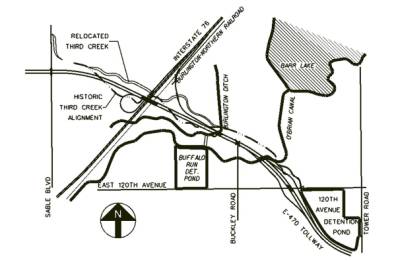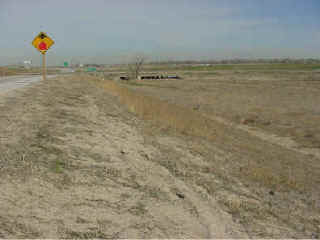Printer-friendly versionE-470 Major Drainageway Design Enhanced Through Regional CooperationBy
| |||||||
 |
The Third Creek basin originates upstream from Denver International Airport (DIA) and flows northwesterly to the confluence with the South Platte River, draining a total of 32 square miles. Adams County and the Cities of Commerce City and Brighton are all affected by Third Creek. Several irrigation canals traverse the basin and several wetland areas are adjacent to the creek. The basin below DIA is presently rural in nature; however rapid development is expected as a result of the E-470 and DIA projects. Third Creek has been studied extensively beginning with a Flood Hazard Area Delineation (FHAD) study prepared by the District in 1976. The District subsequently published an Outfall Systems Planning (OSP) Study in 1990. The Federal Emergency Management Agency (FEMA) published a Zone A floodplain based on the FHAD study. The influence of DIA was identified in a hydrologic update, "Third Creek Implementation Plan", prepared by the District in October of 2000. The FHAD identified a 100-year discharge of approximately 6,000 cfs through the project reach. The OSP identified a 100-year discharge of 10,000 cfs without detention and 4,600 cfs with detention at Interstate Highway 76 (I-76). The attenuated flows include the effects of two proposed detention ponds within the study reach, in addition to DIA detention facilities.
Third Creek and E-470 vicinity |
|

|

|

|
|
Because of environmentally sensitive vegetation within the basin between Buckley Road and I-76, the E-470 alignment was located near or on the thalweg of Third Creek through this reach. Placing a roadway on embankment within the floodplain produced significant impacts requiring careful mitigation. The Third Creek thalweg had to be relocated through much of the project reach. Buffalo Run, a 2.4 square mile tributary, crosses E-470 immediately upstream of its confluence with Third Creek west of Buckley Road. The O'Brian Canal crosses Buffalo Run, Third Creek and E-470. The Burlington Canal and Buffalo Run share a combined E-470 crossing structure.
The problem was to place the E-470 highway embankment along Third Creek with minimal impact to the wetlands vegetation and 100-year floodplain. Early conceptual planning ruled out channelization as envisioned in the OSP due to environmental and groundwater concerns. A plan was developed that utilized elements from the original OSP, modified to accommodate E-470. The plan included using borrow pits resulting from roadway embankment excavations for regional detention ponds. The first pit, located south of East 120th Avenue was designed as a 267 acre-foot online peak shaving detention pond. This pond replicates OSP pond number 261 in terms of general location and function. The OSP identified a second regional detention pond offline from Third Creek, upstream of I-76 to further reduce 100-year peaks discharges to the northwest. That site was needed for wetlands mitigation. The design team identified a borrow pit south of the O'Brian Canal and along Buffalo Run as a potential regional detention pond replacement site. Preliminary design was performed to insure that the borrow pit size was adequate to reduce downstream 100-year peak discharges on Third Creek to approximately the OSP values. Additional analysis and design were performed to identify a future pond outlet system beneath the O'Brian Canal and discharge channel beneath the E-470 mainline bridges. Commerce City, the District and several development groups subsequently completed a separate Buffalo Run master plan effort. The Third Creek low flow channel between East 120th Avenue and I-76 and beyond to Sable Boulevard (State Highway 2) was relocated and widened to minimize impacts to the floodplain. The E-470 design effort was coordinated with CDOT's I-76/Third Creek bridge replacement project.
Coordination between the design team, FEMA and the District was required to update floodplain hydrology for Third Creek. The District provided revised floodplain hydrology, based on existing basin conditions in accordance with FEMA criteria. Floodplain hydrology in this case differed from design discharges, which were based on developed basin conditions. The 100-year discharge at I-76 was estimated at 3,500 cfs while the design discharge at this same location was estimated to be 4,800 cfs. Both a Conditional Letter of Map Revision and final Letter of Map Revision were prepared for the project reach. The District completed the technical review on behalf of FEMA under the Cooperative Technical Partners program.
Because existing wetlands along Third Creek were impacted, a mitigation plan was required. Cooperation with Army Corps of Engineers, Environmental Protection Agency, Brighton, and Adams County, was required to provide an acceptable mitigation plan. The plan included designing the relocated low flow channel as a wetland bottom facility and constructing four wetland mitigation sites adjacent to the creek. The mitigation plan was approved by local jurisdictions and federal agencies.
Cooperation between E-470 PHA--providing the land, the Contractor--completing the pond excavation, CDOT--providing approval of revised hydrology at I-76 and Sable Boulevard, and the District and Commerce City--accepting the borrow pit for use as a future regional detention facility was required to make this plan acceptable. The hard work and cooperative spirit of the stakeholders was essential in developing, reviewing, and approving the proposed Third Creek improvement plans. Time is money on design/build projects. The coordinated effort of the stakeholders allowed construction of the fourth segment of E-470 Tollway to be completed ahead of schedule. At the same time two additional master planned regional detention facilities were constructed and are in place ahead of the development that is expected to follow the highway.